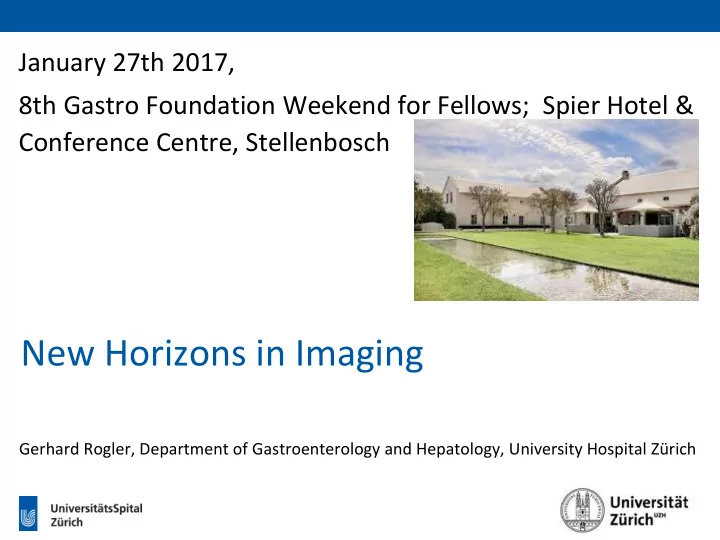

January 27th 2017, 8th Gastro Foundation Weekend for Fellows; Spier Hotel & Conference Centre, Stellenbosch New Horizons in Imaging Gerhard Rogler, Department of Gastroenterology and Hepatology, University Hospital Zürich
Clinical case Female, 27 years of age 8 weeks: diarrhoea (4 – 6 liquid stools/day), abdominal pain, arthralgia Medical history: no diseases, non-smoker Lab parameters: Leucocytes: 12,380/mm 3 , lymphocytes: 1600/mm 3 CRP: 17 mg/L (normal <5 mg/L) Albumin: 31 g/L Stool culture including Clostridium difficile toxins A and B: negative Colonoscopy: no specific findings; terminal ileum intubated for 5 cm; no further ileoscopy possible
Clinical case Female, 27 years of age 8 weeks: diarrhoea (4 – 6 liquid stools/day), abdominal pain, arthralgia WHAT NEXT ???
Imaging modalities for IBD assessment Endoscopy Double-balloon enteroscopy Capsule endoscopy Ultrasound CT scan MRI
Bowel ultrasound: The radiologist’s view Random noise Iris diagnostics Reading tea leaves
Comparison of MRI and bowel ultrasonography Meta-analysis of 68 publications Mean sensitivity estimates for Mean specificity diagnosis of IBD US 0.84 0.92 MRI 0.93 0.90 Panes J, et al. Aliment Pharmacol Ther 2011;34:125 – 145
MRI, CT, scintigraphy and ultrasound in IBD: Meta-analysis of prospective studies Per Patient Sensitivity and Specificity Studie Patients Sensitivity % Specificity % s (n) [range] [range] [78 – 96] [67 – 100] 9 1000 90 96 Ultrasound [76 – 95] [78 – 93] 3 152 88 85 Scintigraphy [77 – 87] [67 – 100] 4 113 84 95 CT [82 – 100] [71 – 100] 7 292 93 93 MRI Horsthuis K, et al. Radiology 2008;247:64 – 79
Imaging MRI Ultrasound
Safety “Theoretic” Cumulative Effective Dose of diagnostic radiation exceeds 75 mSv in 15.5% of patients with Crohn’s disease 120 112 CED <75 mSv Number of patients (n) 100 CED >75 mSv 88 80 70 60 40 29 21 20 20 9 4 1 0 0 – 25 25 – 50 50 – 75 75 – 100 100 – 150 150 – 200 200 – 300 300 – 400 No imaging Cumulative effective dose range (mSv) Desmond AN, et al . Gut 2008;57:1524 – 1529
Safety 10 – 17 mSv CT scan Conservative estimate – 10 mSv: 1 carcinoma in 5000 patients
MRI parameters activity in CD Thickening Hyper- Edema Ulcers enhancement Disease activity Disease severity MaRIA = 1.5 * wall thickness (mm) + 0.02 * RCE + 5 * edema + 10 * ulcers MaRIA, Magnetic Resonance Index of Activity Rimola J, et al . Gut 2009;58:1113 – 1120
Bowel ultrasonography Terminal ileitis Ileocolonic anastomosis
Bowel US features: fistula and abscess Fistula Abscess Ileum
Bowel US in clinical practice High sensitivity and specificity for assessment of IBD manifestations, disease activity and complications Main uses: Initial evaluation of suspected IBD Follow up for assessment of disease activity and complications Advantages: Quick and easy, non-invasive, no preparation, no sedation, broadly available, inexpensive, no radiation, real-time movement, structures outside the gut Limitations: Sometimes limitations in assessing the jejunum, proximal ileum and pelvis Sometimes impaired by gas-filled bowel and by large body habitus
Summary: small bowel examinations in CD Initial diagnosis: MRI, US, (SBCE) Follow up, disease activity: US Negative findings: MRI In case of complications: US, MRI, CT SBCE, small-bowel capsule endoscopy
Magnetisation transfer MRI: examples T2 images (left column), contrast-enhanced T1 images, and parametrical MTR maps (right column) A) Female patient (18 years of age), with acute inflammation in the terminal ileum B) Male patient (29 years of age) with chronic-fibrotic stricture (high MT) C) Male patient (45 years of age), with chronic stricture (high MT) D) Male patient (37 years of age), with acute inflammation (low MT) Pazahr S, et al. Magnetisation transfer for the assessment of bowel fibrosis in patients with Crohn's disease: initial experience . MAGMA 2013;26:291 – 301
Summary Imaging for monitoring will be an essential component of future IBD patient care However, imaging should be problem-driven (“is there a question to answer?” “Will the results of imaging change treatment?”), and not on a strict regular basis Ultrasound may be used instead of endoscopy in many situations for the monitoring of patients with IBD MRI – if available – should be preferred over CT scans New MRI techniques will soon be available
Thank you for your attention
Recommend
More recommend